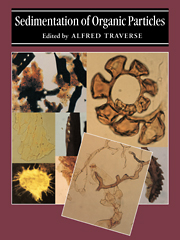Book contents
- Frontmatter
- Contents
- Editor's preface
- List of contributors
- I Introduction
- II Studies of palynosedimentation in modern environments
- 2 The sorting of spores and pollen by water: experimental and field evidence
- 3 Transport and deposition of pollen in an estuary: signature of the landscape
- 4 Pollen preservation in alkaline soils of the American Southwest
- 5 Wind and water transport and sedimentation of miospores along two rivers subject to major floods and entering the Mediterranean Sea at Calvi (Corsica, France)
- 6 Sedimentation of land-derived palynomorphs in the Trinity–Galveston Bay area, Texas
- 7 The genesis and sedimentation of phytoclasts with examples from coastal environments
- 8 Palynofacies of some recent marine sediments: the role of transportation
- 9 Maceral palynofacies of the Louisiana deltaic plain in terms of organic constituents and hydrocarbon potential
- 10 Organic sedimentation in a carbonate region
- 11 An approach to a standard terminology for palynodebris
- 12 Relationships of palynofacies to coal-depositional environments in the upper Paleocene of the Gulf Coast Basin, Texas, and the Powder River Basin, Montana and Wyoming
- III Reconstruction of late Cenozoic vegetation and sedimentary environments from palynological data
- IV Application of data on palynosedimentation to solution of geological problems
- V Appendix
- Index
2 - The sorting of spores and pollen by water: experimental and field evidence
Published online by Cambridge University Press: 06 January 2010
- Frontmatter
- Contents
- Editor's preface
- List of contributors
- I Introduction
- II Studies of palynosedimentation in modern environments
- 2 The sorting of spores and pollen by water: experimental and field evidence
- 3 Transport and deposition of pollen in an estuary: signature of the landscape
- 4 Pollen preservation in alkaline soils of the American Southwest
- 5 Wind and water transport and sedimentation of miospores along two rivers subject to major floods and entering the Mediterranean Sea at Calvi (Corsica, France)
- 6 Sedimentation of land-derived palynomorphs in the Trinity–Galveston Bay area, Texas
- 7 The genesis and sedimentation of phytoclasts with examples from coastal environments
- 8 Palynofacies of some recent marine sediments: the role of transportation
- 9 Maceral palynofacies of the Louisiana deltaic plain in terms of organic constituents and hydrocarbon potential
- 10 Organic sedimentation in a carbonate region
- 11 An approach to a standard terminology for palynodebris
- 12 Relationships of palynofacies to coal-depositional environments in the upper Paleocene of the Gulf Coast Basin, Texas, and the Powder River Basin, Montana and Wyoming
- III Reconstruction of late Cenozoic vegetation and sedimentary environments from palynological data
- IV Application of data on palynosedimentation to solution of geological problems
- V Appendix
- Index
Summary
Introduction
Palynologists extract fossil spores and pollen (collectively ‘sporomorphs’) from rocks representing many different sedimentary environments; these are used as indicators of the surrounding vegetation and climate as well as for stratigraphy. They are of particular use to stratigraphers, as they may be found in both marine and terrestrial sediments and can therefore be used as a link between the two environments.
In the past it was common to believe that most of the pollen was transported to the sediment via the atmosphere as a ‘pollen rain.’ This pollen rain was considered to be relatively uniform over a wide area.
The distribution of pollen through the atmosphere has been studied by many authors (for example, Lanner, 1966; Janssen, 1973). Numerous experiments have been carried out on the dispersion of pollen from both point sources (Colwell, 1951; Chamberlain, 1966) and from forests (Lanner, 1966). Some of these studies were initiated by investigators in other fields of study. May (1958), for example, was attempting to model the dispersion of radioactive particles in the atmosphere and she used Lycopodium spores to do this.
As palynologists recognized the need to be able to differentiate between pollen that had travelled a few meters from that which had arrived at the site from several kilometers away, the pollen rain was interpreted as having three components with arbitrary boundaries: (1) ‘local’ (sporomorphs deposited within a few tens of meters of their source plant), (2) ‘extra-local’ (deposited within a few hundred meters of the source), and (3) ‘regional’ (deposited more than a few hundred meters from their source).
- Type
- Chapter
- Information
- Sedimentation of Organic Particles , pp. 9 - 32Publisher: Cambridge University PressPrint publication year: 1994
- 11
- Cited by



